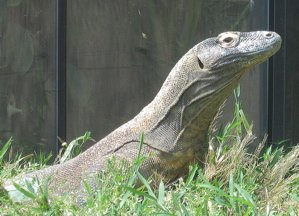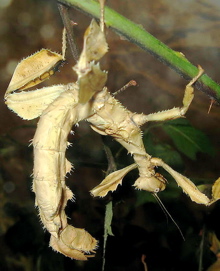On the Origins of New Forms of Life
4.7: Production of New Agamosperms
(Continued from the previous page)

|
| The Komodo dragon, the world's largest lizard, can reproduce without fertilization. |
Recall that:
- Agamospermy is a mode of reproduction in which the embryo develops without fertilization; and
- A parthenogen is a special type of agamosperm in which such development proceeds from an unfertilized egg, and not from other types of reproductive tissues.
(Usually the term agamosperm is restricted to plants, but here it will be used in connection with animals, too, since parthenogens do reproduce in a way that would be called agamospermy in a plant.)
Most, but not all, agamosperms are polyploid.1 However, the stabilization processes producing them differ from those producing sexual polyploids in that they do not require a recovery of pairing via chromosome doubling. The karyotype of an agamosperm can be completely unpaired.
In the great majority of cases, distinct agamospermous somasets are also chromosomally distinct either in ploidy or with respect to chromosomal rearrangements (that is, they are distinct chromosets.2 Since many agamosperms are the products of hybridization between chromosets, the process that produces them is a kind of chromosomal mutation.
The population of Australian lizards designated by the name Heteronotia binoei (Binoe's gecko) contains various chromosets (see photo >>). Moritz (1984) reports that one of them, a triploid parthenogen, arose through a two-stage stabilization process:
- Hybridization between two diploid chromosets produced diploid hybrids; and,
- The hybrids then backcrossed with parental males to produce triploid female parthenogens.
Since the production of unreduced gametes is greatly enhanced in hybrids,3 the backcrossing female hybrids probably supplied diploid eggs that united with haploid sperm from the male parents to produce the triploid females. Because these females were able to reproduce without fertilization, they each founded a separate clonal line of descendants. Note that the production of each parthenogenetic founding female required a chromosomal mutation.
The triploid parthenogenetic snail Campeloma parthenum (Maiden Campeloma) formed via a similar two-step stabilization process.4 The steps were:
- A C. geniculum (Ovate Campeloma) male crossed with C. limum (File Campeloma) female to produce a parthenogenetic diploid;
- This diploid then backcrossed to a C. geniculum male to produce a triploid parthenogenetic female which founded a clonal line (C. parthenum).
Again, the genetic events producing this clone were chromosomal mutations.

|
| Many stick insects engage in agamospermy. |
Scali et al. (2003) studied stick insects of the genus Bacillus. They report the parthenogen Bacillus atticus hybridizes with the sexual B. grandii to produce sexual diploids and a parthenogenetic triploid. The diploids are treated as a species (B. whitei), as is the triploid clone (B. lynceorum).
The origins of the parthenogens just mentioned were inferred from analysis of their karyotypes and genetic constitution. In many cases, however, parthenogenetic forms have actually been synthesized by hybridizing their parents under controlled conditions. For example, two Australian morabine grasshopper chromosets are treated as a single species, Warramba virgo.4 Chromosome studies showed that these two parthenogenetic chromosets arose through hybridization between two other grasshoppers, known as P169 and P196,6 both of which are sexual. One of these parthenogenetic chromosets, composed of the two western clones, "Boulder" and "Zanthus," has been synthesized in the laboratory by crossing the parents, P169 and P196.7
Another grasshopper, the naturally occurring parthenogenetic delphacid leafhopper Muellerianella 2-fairmairei-brevipennis, was produced by hybridization between M. brevipennis and M. fairmairei.8 It, too, has been artificially replicated by crossing its parents. NEXT PAGE >>
Notes: (List of Works Cited)
1. Grant (1981); Suomalainen et al. (1987: 21).
2. White (1973a: 701).
3. Ramsey and Schemske (1998).
4. Johnson and Leefe (1999); Johnson et al. (1999).
5. Suolamainen et al. (1987: 176).
6. Hewitt (1975); White et al. (1977).
7. Honeycutt and Wilkinson (1989); White et al. (1977); White and Contreras (1978).
8. Drosopoulos (1976, 1978).
Most shared on Macroevolution.net:
Human Origins: Are we hybrids?
On the Origins of New Forms of Life
Mammalian Hybrids
Cat-rabbit Hybrids: Fact or fiction?
Famous Biologists
Dog-cow Hybrids
Georges Cuvier: A Biography
Prothero: A Rebuttal
Branches of Biology
Dog-fox Hybrids